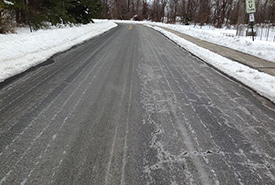Hold the salt, please: The hidden cost of keeping the roads clear

Winter road treatment using salt brine (Photo by Wikimedia Commons, CC BY-SA 3.0)
On a brisk Toronto winter morning, my breath hangs in the air as I walk my dog to a nearby park. Our route may seem meandering, but it’s designed with purpose: finding the salt-free sidewalks.
I’m grateful that the roads and sidewalks are clear, but road salt is hard on footwear and harder on my dog’s paws. Anyone who drives or cycles in the winter knows about the rust it can cause.
These are obvious side effects, but there is also an unseen environmental cost to our dependence on salt. After all, once it vanishes from roads and sidewalks, it has to go somewhere.
Freshwater ecosystems at risk
If you’ve travelled Canadian highways, you’ve probably seen plants impacted by salt, such as evergreens that have turned brown. Across the country, we use over five million tonnes of road salt per year, mostly to make driving safer.
Salt on the roadway mixes with melted ice and snow and the run-off permeates soil and enters nearby waterways.
Salinization of fresh water is a serious concern, as these ecosystems are a finely tuned balancing act. An Environment Canada assessment report from 2001 concluded that high releases of road salts were “having an adverse effect on freshwater ecosystems, soil, vegetation and wildlife.”
Recent research in Freshwater Biology warned “the costs to freshwater ecosystems may be severe if actions are not taken to mitigate road salt salinization.”
What impact does this have on wildlife? In one case, exposure to chloride through dissolved salt was found to be toxic to young freshwater mussels in Ontario.
In another study, researchers at the University of Toronto discovered the immune system of dragonflies was impacted when they were exposed to high-saline water.
And it’s not just roadside trees and freshwater species that are being affected. Canadians depend on these watersheds for drinking water. In the Waterloo area, chloride levels in drinking water have continued to rise since monitoring began in the 1970s, with road salt being blamed. Some wells tested exceeded Ontario’s drinking water standards for chloride of 250 milligrams per litre.
Fortunately, measures are being taken to address this issue.
Reducing salt use
Many cities and regions have published salt management plans to reduce the amount used. In Ontario, Conservation Ontario and the Good Roads Association published a guide outlining good practices for applying salt in vulnerable areas. There are also federal guidelines for safe chloride levels in surface water, groundwater and soil.
Alternatives to road salt are also becoming more popular, with some success stories out there. Calgary has been experimenting with lower-salt content beet juice brine. Some regions have begun spraying roads with a wet salt brine, which works more efficiently than dry road salt.
How can you make a difference?
For those of us toughing it out this winter, here are some suggestions:
- Shovel your walkways to bare pavement to avoid ice buildup.
- Use sand and kitty litter as safe alternatives and still provide grip.
- Consider suggesting to neighbours and friends that they try going salt-free with you.
- If you use salt to melt ice, apply it sparingly and only in the area of highest foot traffic.
As for my dog and his paws, I’m always relieved when we get to the snow-covered fields of the park. At least until the walk back home.


